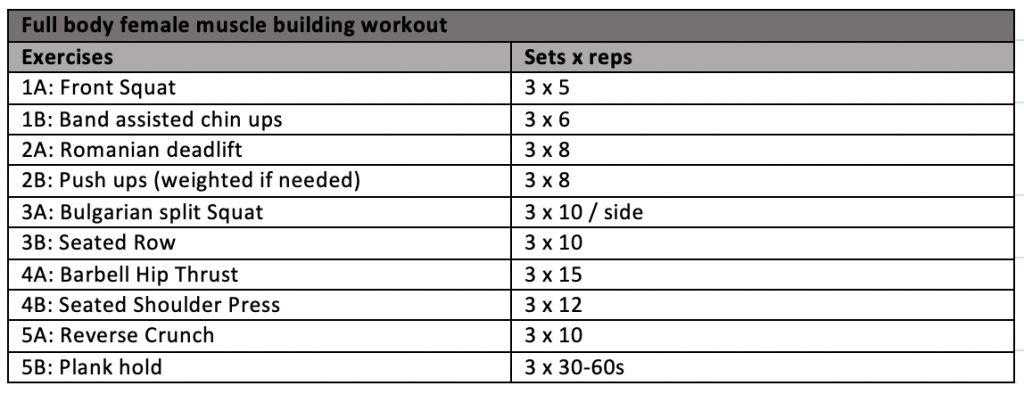Muscular Potential: Men vs Women

It has long been thought that when it comes to building muscle, women are at a massive disadvantage.
Whether it be because of hormone levels, muscle fiber distribution, or some other factor that we aren’t yet aware of, it doesn’t matter – people seem to think that women cannot build anywhere near as much muscle as their male counterparts.
But is this really the case? Or is it simply a myth?
The natural muscular potential of women: can women gain the same percentage of muscle mass as men?
So, the million-dollar question – can women gain as much muscle mass as men?
We know that in more traditional settings, females have typically been less muscular than men – but interestingly, this doesn’t necessarily mean that they cannot build as much muscle as men.
Especially when we start to look at it from a relative perspective (Ralston, 2018).
When we take a dive into the research, it quickly becomes apparent that women have the capacity to gain the same percentage of muscle mass as men across a given strength training program – and interestingly, they may even experience larger relative strength gains.
This essentially means that if you have a group of males and a group of females exactly the same training program, they would very likely see similar percentage increases in muscle growth.
In short, females appear to exhibit the same potential for muscle growth as men.
Related Article: Endurance Athletes: Why Women Win In The Long Run
Body fat regulation in women
If this is the case (which it is), then you might be wondering why it is perceived that women cannot gain as much muscle mass as men – and some people believe that it might come down to body fat regulation.
You see, as a general rule of thumb, women tend to carry greater amounts of fat mass on their body than men.
Conversely, men typically have more muscle mass (Schorr, 2018).
However, this isn’t related to anything regarding exercise – in fact, this extra fat is very important.
Women need to have around 12% of what we would consider being essential body fat. This fat is deemed essential because it helps regulate hormone function and maintain cardiovascular and metabolic health,
Alternatively, men only need around 3% of essential fat.
It is ultimately this difference in fat mass that changes the observed percentages in muscle mass between males and females – but it obviously does not mean that women are incapable of building more muscle tissue.
Do hormones play a role in muscular development?
Now wait just a minute – this is all well and good, but don’t men and women have different hormone levels? And won’t that impact their muscular potential?
Apparently not.
It is commonly thought that women simply cannot grow muscle at the same rate as men because they have less testosterone – which is true – in fact, females have about fifteen times less testosterone than men (Pielke, 2019).
But that doesn’t seem to have a huge impact on their potential for muscle growth.
This is because, while testosterone does play a predominant role in promoting muscle growth in men, it functions a little differently in women. In females, it plays a more predominant role in the maintenance of health.
As a result, in women, the human growth hormone takes over the anabolic role that testosterone plays. In this manner, women produce and secrete around three times the amount of growth hormone than men do, which obviously improves their muscle growth potential.
It is also important to note that the hormone estrogen plays a role in the development of muscle tissue in women, where it does not in men. Again, females obviously produce much more estrogen than males.
Both of these key factors appear to mitigate the apparent differences in testosterone levels between men and women, which results in the same potential for muscle growth (Tomeleri, 2019).
Pretty cool, right?
Does DNA have a role in the development of muscle mass?
What about DNA – does DNA affect muscle gain?
As I am sure you can imagine, yes it can.
There has been a large portion of research looking to determine if there are any key genes that can enhance your muscle growth. While this research is still only in its infancy, there is some evidence to suggest that certain genetic factors can potentially impact your capacity for muscle growth by improving your body’s ability to physically build new muscle tissue (Ahmetov, 2015).
Of these, the ACTN3 gene appears to be the best researched.
Now, with this in mind, it is important to note that these specific genetic factors are unlikely to influence your potential for muscle growth. This is going to be dictated by the size of your skeleton, and your physical makeup (which I explain in more detail in our next section).
It simply means that people with a good genetic predisposition have the capacity to reach their muscle building potential faster and more efficiently than those who have a more aerobic disposition.
What about the 3 body classifications?
I cannot talk about the topic of muscular potential without touching on body type classifications.
Classifying people in accordance to their body type is not a new thing.
In fact, the entire concept was first introduced in the 1940s by a researcher named William Sheldon. Professor Sheldon discovered that people could fall within one of three body types, known as somatotypes.
The three somatotypes that we use to classify body types are (Marangoz, 2018):
Mesomorphs:
Characterized as being hard, rugged, and athletically built. Mesomorphs tend to have well-developed muscles, thick skin, and good posture. Additionally, they tend to build muscle mass with little effort and retain little fat.
Endomorphs:
Characterized as being short and squat in stature. They typically gain fat faster and have a harder time getting it off. Their natural build is wider than that of either a mesomorph or an ectomorph. They have a good capacity for muscle growth (although can gain fat in the process), and their shorter limbs predispose them to explosive strength sports.
Ectomorphs:
Characterized as being tall and thin, and also tend to have a lean build with small muscles and long limbs. They struggle to gain weight at all (whether it be muscle or fat) and are the least broad of three somatotypes.
While your somatotype isn’t everything, it does appear to play a role in your potential to improve both muscle growth and performance. In this manner, mesomorphs tend to experience the fastest increases in strength, power, and muscle growth, while ectomorphs see the fastest improvements in aerobic endurance (Sterkowicz-Przybycień, 2018).
Still, it is obviously important to remember that you are never doomed to a specific outcome.
You will always have the potential to build muscle, irrespective of your body type – it just means you might have to work a little harder to do so!
Why women aren’t living up to their potential?
We now know that women have the potential to grow the same percentage of muscle mass as men – but we rarely see it.
I mean why don’t we see more muscular women. Why aren’t women living up to their muscular potential?
As unexciting as it is, I honestly think it comes down to social norms.
Weight training is still seen as a masculine activity, even irrespective of the many health benefits it offers for all genders. Then there is also the complexity of how people think they should look, and whether being muscular is viewed as a part of that or not.
While it is certainly becoming more popular for women to step into the gym and strength train, it is still in its early stages – and hopefully, over the next few years, we will see more women living up to their muscular potential.
Related Article: 5 Ways HIIT Improves Fitness in Women
Tips for women to build more muscle mass
Given all of the above, I wanted to give you some tips for women to gain muscle. Each of these is tried and true methods of increasing muscle mass, and therefore offer the perfect way to promote muscle growth.
- Increase your training frequency: women are more fatigue resistant than men. This means that their recovery is faster between workouts, sessions, and even sets. As a result, you can train more often, which directly increases muscle growth. This might even mean 3 full body gym sessions per week to maximize muscle growth.
- Use a variety of rep ranges: lifting heavy loads for lower reps is a great way to stimulate type II muscle fiber growth. Lifting lighter weights for higher rep ranges is a great way to promote type I muscle fiber growth. Use both methods regularly.
- Prioritize large compound movements: large multi-joint movements allow you to use the most load and take you through larger ranges of motion. This is integral to enhancing muscle growth.
- Superset exercises: super setting exercises (performing them back to back with minimal rest) can increase growth hormone secretion during a workout – which we know is important for female muscle growth.
- Consume adequate energy: to build muscle, eating in a slight calorie surplus is essential to growing muscle tissue. Eating enough protein is a key component of this, so don’t shy away from protein-rich foods.
By implementing the above tips, you can easily take your muscle growth to the next level.
Effective muscle building workout example
Last but not least, and using the tips above, I wanted to provide you with a muscle building workout that you can perform three times per week.
In this workout, ‘A’ and ‘B’ exercises are performed as supersets, where you move straight from the ‘A’ exercise to the ‘B’ exercise, and then rest for approximately 60 seconds before repeating.

Trust me when I say this one isn’t going to be easy – but it will be effective!
Take Home Message
Despite what many people will have you believe, women actually have the same relative potential for muscle growth as men. It is just a matter of getting your training right and putting in the time and effort.
The tips outlined in this article can help you gain some serious muscle mass, and reach your muscular potential – so what are you waiting for?
References
Ralston, Grant W., et al. “Weekly Training Frequency Effects on Strength Gain: A Meta-Analysis.” Sports medicine-open 4.1 (2018): 36.
Schorr, Melanie, et al. “Sex differences in body composition and association with cardiometabolic risk.” Biology of sex differences 9.1 (2018): 28.
Pielke, Roger, Ross Tucker, and Erik Boye. “Scientific integrity and the IAAF testosterone regulations.” The International Sports Law Journal (2019): 1-9.
Tomeleri, Crisieli M., et al. “Influence of Resistance Training Exercise Order on Muscle Strength, Hypertrophy, and Anabolic Hormones in Older Women: A Randomized Controlled Trial.” The Journal of Strength & Conditioning Research (2019).
Ahmetov, Ildus I., and Olga N. Fedotovskaya. “Current progress in sports genomics.” Advances in clinical chemistry. Vol. 70. Elsevier, 2015. 247-314.
Marangoz, Irfan. “The Determination of the Relationship between Somatotypes and Speed of Sub-Elite Athletes.”. Asian Journal of Education and Training 4.3 (2018): 220-223.
Sterkowicz-Przybycień, Katarzyna, et al. “Somatotype, body composition, and physical fitness in artistic gymnasts depending on age and preferred event.” PloS one 14.2 (2019): e0211533.












